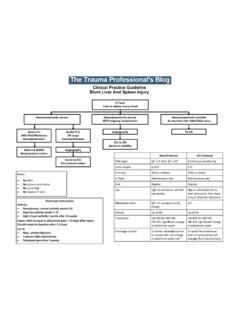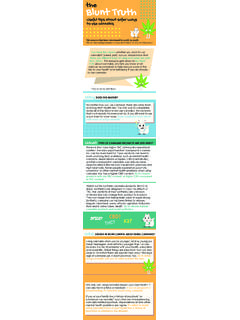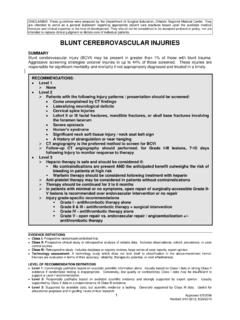Transcription of Blunt trauma to the larynx and trachea - phillyvoicemd.com
1 Blunt trauma to the larynx and trachea : Considerations for the Professional Voice User Yolanda D. Heman-Ackah, MD and Robert T. Sataloff, MD, DMA INTRODUCTION Blunt injury to the larynx (the voice box) and trachea (the windpipe) is the most common cause of laryngo-tracheal injury in the United States today, accounting for sixty percent of all injuries to the laryngotracheal ,2 These injuries result from motor vehicle collisions, accidents involving all-terrain vehicles, bicycle accidents, stage injuries, contact sports, strangulation, and hanging-type injuries. The complications associated with such injuries range from airway obstruction and difficulty breathing to voice compromise and permanent hoarseness, with compli- Journal of Singing, September/October 2002 Volume 59, No.
2 1, pp. 41-47 Copyright 2002 National Association of Teachers of Singing cation rates as high as fifteen to twenty-five Because of the potential for untreated laryngeal and tracheal injuries to cause permanent voice, swallowing, and breathing dis-abilities, early evaluation and treat-ment by an otolaryngologist or laryngologist (an otolaryngologist who specializes in the treatment of laryngeal and voice disorders) is imperative. It is essential for singing teachers to be familiar with these problems and their proper management. Symptoms and signs of voice-threatening, and even life-threatening, injuries maybe subtle and dismissed even by some physicians as insignificant. Even an injury caused by something as innocent as an arm or elbow striking the neck of a fellow actor, dancer, or singer during a theatrical perform-ance can be disastrous unless recog- nized and treated promptly.
3 Singing teachers are often the first profes-sionals in a position to recognize the potential importance of such an appar-ently "minor" event. LARYNGOTRACHEAL ANATOMY The larynx is relatively protected from trauma by the overhang of the mandible (the jaw) above, the bony prominence of the clavicles (the col-larbone) and sternal manubrium (the breast bone) below, and by the mass of the neck muscles on the sides. The framework (structure) of the larynx consists primarily of four cartilages, the thyroid, the cricoid, and the paired arytenoid cartilages. The thyroid cartilage is shaped like a shield and forms the protective casing for the vocal folds. The prominence of the thyroid Care of the Professional VoiceASSOCIATE EDITOR: Robert T. Sataloff, MD, DMA SEPTEMBER/OCTOBER 2002 41 Yolanda D. Heman-Ackah, MD and. Robert T.
4 Sataloff, MD, DMA cartilage in the necks of men is often referred to as the "Adam's apple." The arytenoid cartilages sit on top of the cricoid cartilage in the back of the larynx and serve as points of attachment for the vocal folds. In the front of the larynx , the vocal folds attach to the inner aspect of the thyroid cartilage, and thus span the distance between the arytenoid and thyroid cartilages. The cricoid cartilage sits below the vocal folds and is shaped like a signet ring. The ring-like structure of the cricoid serves as a stent to help hold open the airway below the vocal folds. The trachea connects to the bottom portion of the cricoid cartilage and serves as the conduit for air to pass through the larynx to the lungs.
5 The muscles of the vocal folds and the other muscles of voice production attach to the thyroid, cricoid, and arytenoid cartilages. If a normal voice is to be produced, each of these cartilages and muscles must function properly and lie in its correct anatomical location. Displaced fractures of the cartilages, tears in the vocal fold and/or laryngeal muscles, or dislocations of the arytenoids from their normal positions on the cricoid cartilage (cricoarytenoid dislocation) often result in hoarse or breathy voices and, occasionally, airway obstruction and breathing difficulties. Dislocation of a cricothyroid joint (the joint that connects the cricoid and thyroid car-tilage) may result in loss of the ability to change pitch.
6 ' ADULT LARYNGOTRACHEAL INJURIES FROM Blunt trauma Laryngotracheal injuries are rela-tively rare in adults, except when there is a direct blow to the neck. In motor vehicle collisions, the typical victim of laryngotracheal trauma is an un-belted, front seat passenger or driver in a vehicle without protective air bags. Upon collision, the front seat passenger or driver is propelled for-ward with the neck in extension, elim-inating the jaw as a protective shield. As the front of the neck hits the dash-board or steering wheel, the cartilages of the larynx are crushed against the spine of the neck.'," Lower impact, direct blows to the larynx can occur during athletic competition (such as playing basketball, hockey, or foot-ball); during dances, stage fights or other performance activities; while falling forward onto a Blunt object such as the handle bars of a bicycle; with strangulation; or with hanging of the neck from a suspended rope or wire.
7 Such forces also compress the larynx and trachea against the spine, resulting in injury. The thyroid and cricoid cartilages interact dynamically to protect the airway from Blunt injury' Forces to the front part of the larynx often are encountered first by the thyroid car-tilage, which bends against the cer-vical (neck) spine on impact. The thyroid cartilage eventually reaches a point of maximal flexibility, and a fracture occurs often at or near the midline of the cartilage. Vocal fold injuries result from ver-tical fractures of the thyroid cartilage. As the thyroid cartilage snaps back from its compression against the cer-vical spine, the thyroarytenoid mus-cle and ligament (which together comprise the vocal fold) may tear, resulting in a separation at any point along its length.
8 This may be evident as lacerations or hemorrhage (bleed-ing) of one or both vocal folds. The mucosa (the lining tissue) on the ary-tenoids may be denuded or avulsed. Because of the traction on the ary-tenoids from the spring-like motion of the thyroid cartilage as it snaps back from the spine, the arytenoids may also become displaced from their joint space, resulting in cricoarytenoid dis-location. If one segment of the thy-roid cartilage fails to return to its normal position, an overlapping fracture may occur, resulting in malposition of the vocal fold. All of these injuries will result in hoarseness that may not resolve unless the injured tissues and cartilages are repaired; and even then, some permanent voice deficit is common. After the thyroid cartilage frac-tures, the force then impacts the cricoid ring, which was previously shielded by the thyroid cartilage.
9 In a patient with a marked laryngeal prominence, multiple fractures of the thyroid cartilage may occur prior to the distribution of force onto the cricoid cartilage.' The cricoid has a relatively thin front arch that blends on the sides into a thicker, more sturdy cartilage. The thicker regions on the sides of the cricoid cartilage provide most of the support for this portion of the airway. Lower level impacts, such as elbow injuries to the neck, may result in cricothyroid joint injuries or in midline fractures of the cricoid. The airway is maintained by the thicker cartilage on the sides of the cricoid cartilage. With higher impact forces, secondary fractures can occur on the sides of the cricoid cartilage, resulting in airway collapse and possible injury to the recurrent laryngeal nerve (the nerve that sup-plies motor function to the vocal folds) due to impingement of the nerve by segments of fractured cartilage.
10 If the force is severe and/or low in the neck, complete separation of the larynx and trachea may occur.' This situation is potentially life-threaten-ing and requires emergent medical care. Separation usually occurs below the cricoid cartilage, resulting in dis-placement of the trachea into the chest 42 JOURNAL OF SINGING Care of the Professional Voice and collapse of neck tissues into the airway, with consequent airway obstruction and difficulty The neck muscles may serve as a temporary opening for air until edema (swelling) and hematoma for-mation (bleeding into the tissues) result in obstruction of this tempo-rary airway. PEDIATRIC LARYNGOTRACHEAL INJURIES FROM Blunt trauma Fractures of the thyroid and cricoid cartilage from Blunt trauma are un-common in children. The greater elas-ticity of a child's cartilages makes them more resilient to external stresses.








